Raised in Radcliffe, near Manchester, Michael Crompton is an accomplished textile weaver with a particular focus on cotton.
His grandmother taught him from a young age to avoid working in the mills as she had. Years later, an enlightened teacher at his school taught Michael how to create textiles outside of an industrial environment.
In this guest post, Michael Crompton takes us on a journey to his childhood in Manchester, the moment he experienced day and night simultaneously, and an in-depth look at some of his most fascinating work.
Working cotton looms
My name is Michael Crompton and I have been a textile artist since the early 1960s.
I was born in 1943 in the industrial town of Radcliffe, just north of Manchester. Like so many of my contemporaries I was expected to find a job in one of the many factories and mills within the area. My grandmother started working in a mill at the age of about twelve, around 1900, sweeping and cleaning under the working cotton looms.
As she grew, she graduated to a bobbin winder and finally to a loom minder and worked up to six looms at the same time. When she heard that I was thinking of finding a job in a mill she summoned me and told of the many dangers and hazards of such places. She was stone deaf from the noise of the machinery, the continuous drive belts of the Lancashire Looms, the recalcitrant flying shuttles which would shoot up through the warps and of the air filled with cotton fibres; all were a real danger and must be considered most seriously.
For all this I was fascinated by the “dark satanic” mills, larges edifies, a source of great heat, of steam and smoke billowing from the chimney, and the ant like trails of workers entering and leaving at the beckoning of the factory hooter. This was my playground and where I spent my childhood. It was here that I found discarded yarns, bobbins, and strings, old bits and pieces from looms and textile machinery and I soon became absorbed by knotting, embroidery and weaving.
Just as I was about to leave school I was introduced to the world of the “Arts and Crafts” movement, of William Morris and his ilk. Here was an alternative to the Mill system that of the country workshop using local materials and making products by hand for the local population. I had found my pathway and one which I still travel.
Tweed fabrics, rugs & decorative hangings
I was fortunate to find Bishop Otter College, Chichester where I could take a teaching qualification and also study textiles and wood. This was a glorious and stimulating experience for the college environment. It was rich in original works of art by many important makers of the twentieth century. Many wonderful two- and three-dimensional pieces by Rouault, John Bratby, Stanley Spencer, Ivon Hitchens, Henry Moore, and an exquisite tapestry by Jean Lurcat, were hung in the New Chapel.
I left Bishop Otter with a loom and Mary, my future wife, and whilst following a teaching career I continued to weave tweed fabrics, rugs and decorative hangings.
In 1972 we moved from Berkshire and the primary education scene to St Hild’s College, Durham where I was a Senior Lecturer in Textiles and Design, eventually moving to the School of Education, University of Durham.
In the mid 1970s, I realised that my pathway was leading to spending all my time with my textiles and weaving. In 1977, we moved to the old blacksmiths cottage in the Upper Weardale village of Ireshopeburn high in the Northern Pennines of County Durham, finally resigning from the University in 1982 to follow my textile career.
There in the forge we set up our looms and welcomed interested visitors who experienced a country craft workshop. It was only natural that the environment played a large part in my creative thought processes. The forms and shapes, colours and hues were ever changing throughout the year, as were the sights and sounds, the aromas of new mown hay, and early spring growth, all found their way into my textiles.
Conscious that I was mainly part of a mechanical process of weaving on a four shaft floor loom, I became more and more interested in the field of tapestry weaving. For me this was an important development. I could have taken a course at an art school or similar but chose another route and a very different experience.
Being involved with teaching and teachers, I felt that I did not want to be “taught” by a teacher. Instead, I located a practising tapestry weaver in Province in Southern France, Daniel Drouin, and I spent some time there assimilating from the rich learning environment of a tapestry studio.
Yes, I learnt a great deal but the most important aspect was the whole approach to the ways of designing and weaving. Tapestry is an amalgam of the thinking Artist and the Craftsman Weaver. Before weaving can start I have to have an image, which means that concepts, ideas and thoughts must be explored. This pathway is long and my philosophy is continuing to progress and mature.
Simple vertical frame loops
I use simple vertical frame looms with pegs top and bottom and these allow me to increase or decrease the number of threads in the warp. Having made looms all my life I have found that gradually I have simplified them to the basic rectangular shape without any shedding devices. Using a continuous warping method there is no need for a sophisticated tension device. I prefer to use a France style tapestry bobbin which is both a placer/beater and acts as a reservoir for my yarns.
Finger shedding is not the slow process I once thought. As a beater, I prefer a four prong fork, silver preferred, but stainless or EPNS is fine, as the tines can be bent for each particular warp. The yarns I use are two and three ply rug yarns with a high percentage of wool (90% wool and 10% man made) and are chemically dyed and moth resistant. Working with two strands I can accommodate colour matches.
In all my work I concentrate on the curved line. A curve line denotes movement and hence time. My themes and concepts often revolve around past time, present time and future time and include the transitions from one season to another, and the cycles of both the sun and the moon.
Perhaps the most influential aspect is the link between the physical world and the spiritual world. I describe this as the “tingle zone”, that primary experience that sends shivers down the spine or bombards the mind with emotion. Whether it is the cool vastness of a great cathedral, or the sight of the high peaks in the Himalayas, or the emptiness of the Namibian deserts help to recall sensory memories and special feelings.
This is fundamental to my ways of working. I have never thought about starting and ending, always concentrating on a developing and evolving my “process”. I look at how other artists and makers go about their approach. I also read widely around subjects and listen to music, and attempt to make a visual interpretation of sound. To find a resonance between ideas and a design or cartoon occupies my thinking.
The days are round
Just as Jean Giono, the French author said,
“The days are round.”
Similarly, my thinking is always ongoing. I make collections of natural objects, of eroded stones and driftwood, seed heads and anything that contains colours, textures and forms all to aid me in the exploration of an idea. Using coloured yarns, I wrap selected colours around a piece of card to recreate the colours in the environment. This helps me to understand how one colour reacts with its neighbour.
My sketchbooks contain not just drawings, but my own writings, prose, poetry, observations, quotations, and anything that may make a contribution. I capture and identify forms, and then analyse and synthesise component parts, aiming for a simplification while capturing the essence.
These books are referred to months and even years later for they may be seen as an adjunct to a vocabulary. I have found this approach to be vital, especially when travelling and when I am away from my studio. I draw and use watercolours to explore my ideas and concepts. If I am following a theme I may well make six, 10 or even more water colours.
Often, other ideas are created and I allow myself to follow. The decision to take an idea into tapestry is never rushed. While investigating a theme I often find that I have arrived at a point that a tapestry beckons.
I consider now that ideas and a defined design find me. I no longer need to search for them in my head for now it is my heart that dictates. By concentrating on the process rather than an end product, my concepts and perceptions are enhanced. I am able to meander off a given path and to discover new aspects, to remember past encounters and take these into future.
“Past emotions, experiences create the present and the future.”
Having been in a country workshop since 1977, we moved across the Pennines to the Morecambe Bay area in 2002. Without the need to continue as a business I am able to concentrate much more on my enthusiasm for woven textiles.
The thinking of a creative person
At the moment I am thinking around some of the poetry of the Romantic poets, P B Shelley et al. For many years I have enjoyed the works of G M Hopkins and T S Eliot. Putting imagery to their enigmatic writing is a real challenge. One stanza which has accompanied me through my creative life is:
“We shall not cease from exploration
And the end of all our exploring
Will be to arrive where we started
And know the place for the first time.”
Little Gidding – T.S.Eliot.
I would encourage any textile artist, or indeed anyone, to read this and to think how it can influence the thinking of a creative person.
Two artists whom I have looked to are Edvard Munch, the Norwegian impressionist and Paul Gauguin the Post-Impressionist. Both worked in a style, a form of “cloisonné”, where they identified specific shaped areas and then added colour. This is similar to my work where individual areas are conceived and interpreted as separate yet part of the whole and all with a contemporary manner. I see landscape as a series of interlocking shapes.
Day and Night
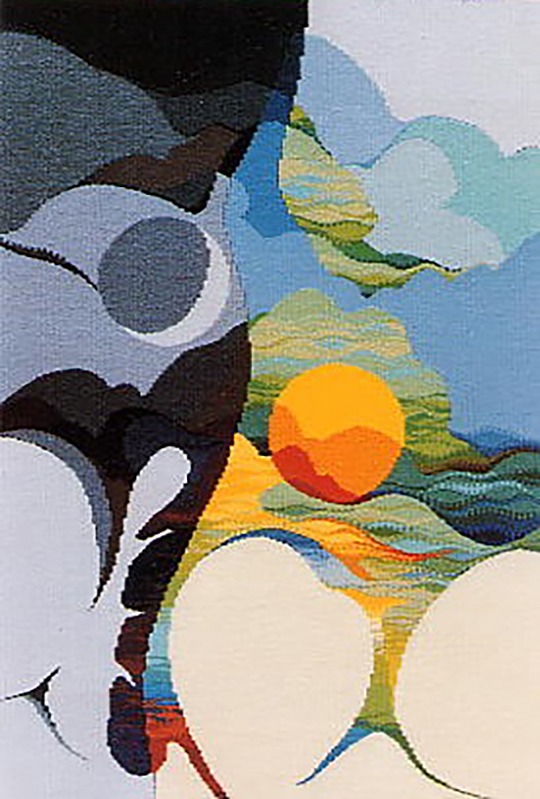
It was whilst flying over the North Pole to California that I looked out of the aircraft window on the right hand side and saw the sun and day. Moving across the aisle to the other side windows the view was of the moon and night. From this initial experience I was fascinated by being able to see two different times, so different that I was unsure whether it was day or night.
I have in later tapestries included the juxtaposition of both the sun and moon in their differing shapes and positions to challenge the viewer.
Le Carrefour – The Crossroads

During the previous months I felt I had reached a point in my weaving unsure as to how to proceed. Whilst I had been drawing and reading, gathering colour combinations and reviewing recent work I saw little to indicate how I was to move forward. Gradually, over a period of time, my thoughts began to materialise. I was at a crossroads uncertain whether to move forward or to look back at previous sources, or to move to the left or to the right. This movement, whichever way I was to go, should be included in the chosen design. It should also reflect the landscape of Weardale and its environs. Looking back suggested that the four chambers of the heart along with the four elements could play a part.
The selected design includes the characteristic dry stone walls of the North Pennines. I always look over them in some way to see over and beyond. This scene, of fields and fells, often with a changing light emphasising the natural world. I have included a pathway up towards the top of the fell typifying man’s aim of reaching for the summit, whatever that might be. On the left is the shape of a foot as man moves through life and towards the unknown. The four chambers of the heart give structure to the colours of the four elements, red for fire, greens for earth, blues for water and light blues for air. Over and through the dry stone walls are arcing, stretching limbs, once again epitomising man’s journey, and mine. The clouds overlap and over laid set in a darker background with the light concentrated on the centre of the crossroads.
I have now found out just where I am and can look forward with the confidence this tapestry has given me.
Looking Back to the Future

“I am at a personal crossroads.
How do I decide which direction to take?
New horizons?
Past pathways?
New concepts and ideas or
Previous gleanings?
How will past experiences help my decisions?
To look forward I may have to look back
A return – to what?
A new outlook?
Past traditions forge the present but enthusiasm and energy create the future.”
These words taken from a sketchbook hark back to an earlier tapestry, “Le Carrefour”.
This piece is very idiosyncratic as its design is predominantly based on our life and the shapes, colours and textures of the Northern Pennines. Gone are the stone walls, the interlocking shapes of valleys, dales and gorges. Movement is more pronounced, the verticals giving the line of life’s journey with a hint of plant growth. The light background so redolent of the “known” and with only restricted areas of the dark, the “unknown”, are included.
The four elements are present as are the four chambers of the heart all this within the outline of the side view of the human head facing fright. My aim was to extend this thinking far beyond the confines of the Dale for the concepts are universal.
Nepal Series
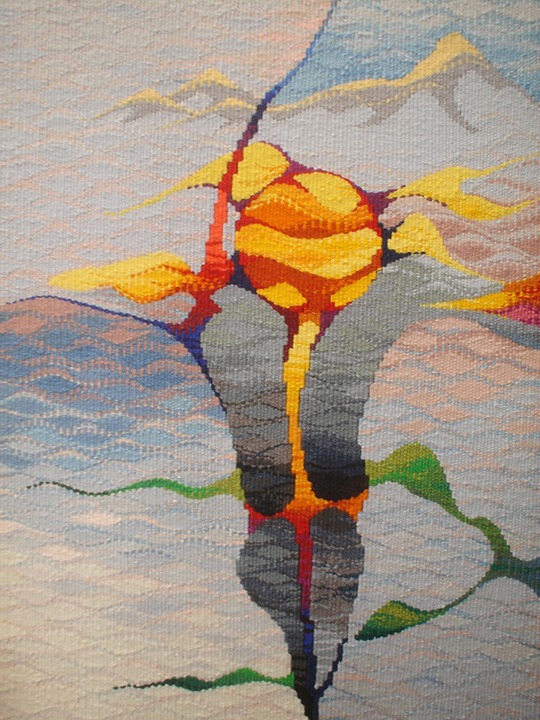
This tapestry is one of a series of four and is concerned with the close relationship between the physical world and the spiritual world of the people of Nepal and the Himalayas. Having visited this area on a number of occasions the impact it has made upon me is considerable.
The environment of the “High Places”, the Himalayas plays an important role in the lives of the people. This design attempts to show the link between the hard landscape and their spiritual beliefs. A human figure formed from eroded rock, sturdy and robust placed beneath the high peaks where ordinary people cannot reach. These peaks seem to belong to another world and the religious belief is where the gods live. The colours yellow and gold represent this as they are symbolic of enlightenment and religious belief. The journey to “enlightenment” is both long and arduous taking a whole life span. It may be that it is unattainable but it is the journey which is so important.
Oak in Moonlight
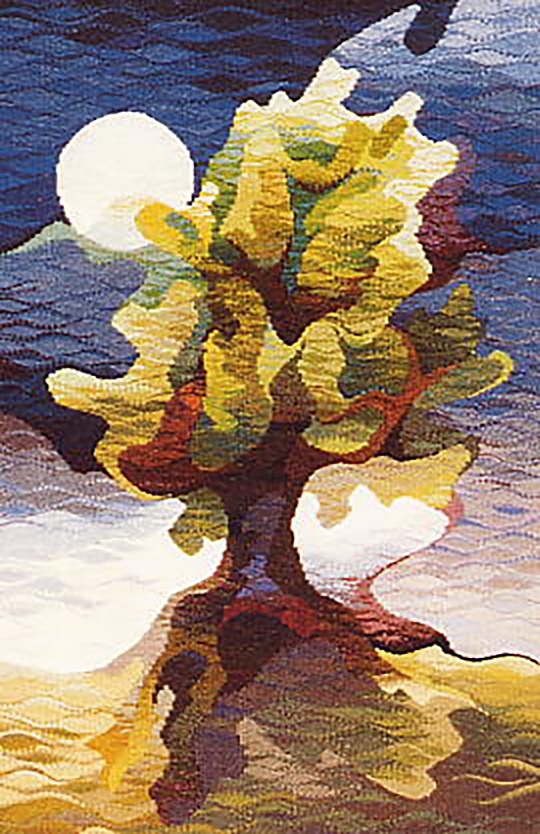
This single free standing Oak is symbolic of longevity having survived for centuries, it has witnessed countless cycles and changes of seasons. The typical shape of its leaf has been incorporated into its overall shape and in the roots. This echoes the annual transition when the leaves fall to the ground in autumn, and over the winter and early spring turn into rich compost to give back nourishment and strength, new growth and hope for the future.
The Tapestry was woven during the millennium year and I chose to make much of the old and the new: a fresh beginning hence the moonlight giving way to dawn. From the base of the ancient trunk and arising from the horizon a burst of light signifies a new dawn and a new day.
Stanhope Tapestry & The Struggle for Life
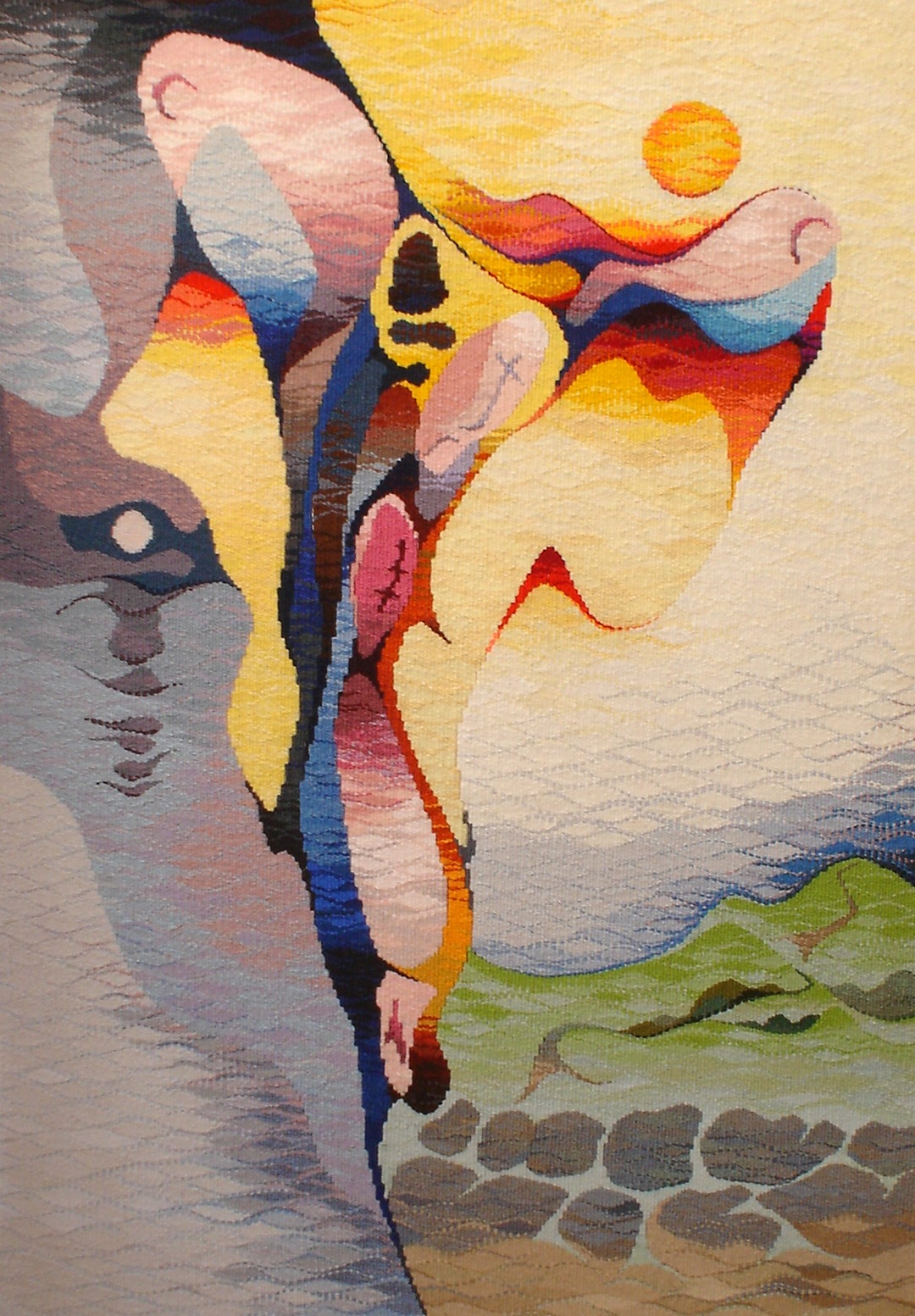
Weardale is a special place.
The people who live, work and play out their lives amid the beauty and harshness of the Northern Pennines know only too well the problems and opportunities that exist along the banks of the River Wear. Those who worked the lead mines and the land are accustomed to the “Struggles of Life”. The seasons whenever they occur can be harsh and severe, welcoming and accommodating, yet always bring their own picture of natural beauty.
Having spent many years in the Dale working and bringing up a family I have included many of my thoughts and feelings for this place in the design for a tapestry. The basic form of a figure has its origins in a piece of natural wood and a remarkable rock structure. It has seemed to me that whenever and wherever I am in the area I am always looking over dry stone walls. While the early dawn and dusk are evocative periods of the day, the night especially with a full moon has its own attraction. This encompasses the unknown of the dark to the known of the day. The horizons of the fells go on forever, the skies ever changing and the reflections all add up to create a special atmosphere. The vast array of colours and textures also make their contribution. All this adds up to a place where the physical world meets the spiritual world. This for me represents a “tingle zone”.
A figure representing a struggle is positioned astride the night and the day, the unknown and the known and the spiritual and the physical worlds also incorporate the feeling of a renewal, a rebirth, it has echoes of the crucifixion.
It is the people in the community who make the Dale with their warmth and enthusiasm, their fortitude and zest for life and living. It is for these that this tapestry is dedicated as a celebration and a commemoration for all who live their lives in the splendour of Weardale.
Have a question for Michael? Email him at: marymichael[at]talktalk.net
Which of the showcased pieces by Michael Crompton are you most impressed with? Let us know with a comment below.
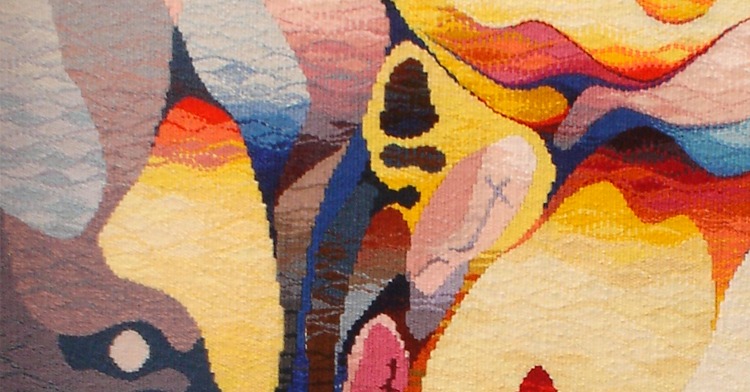
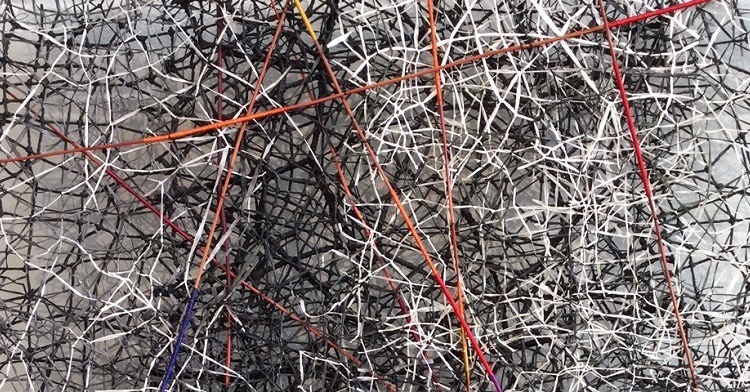

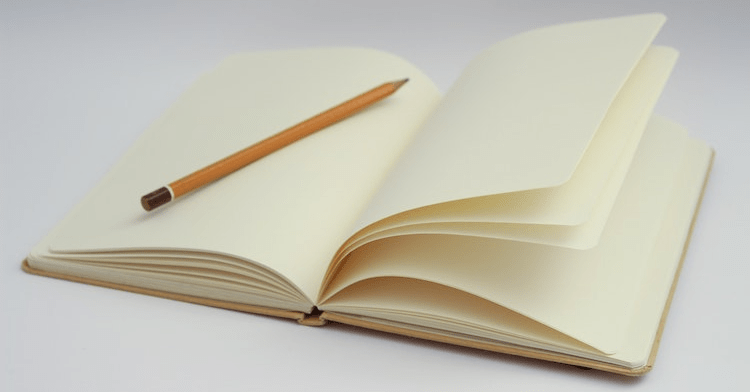
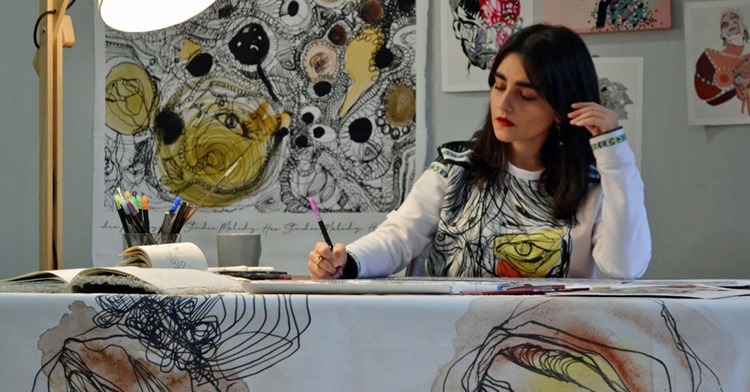
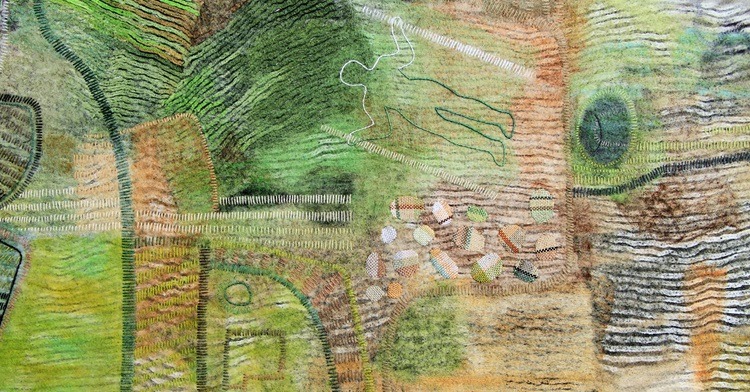
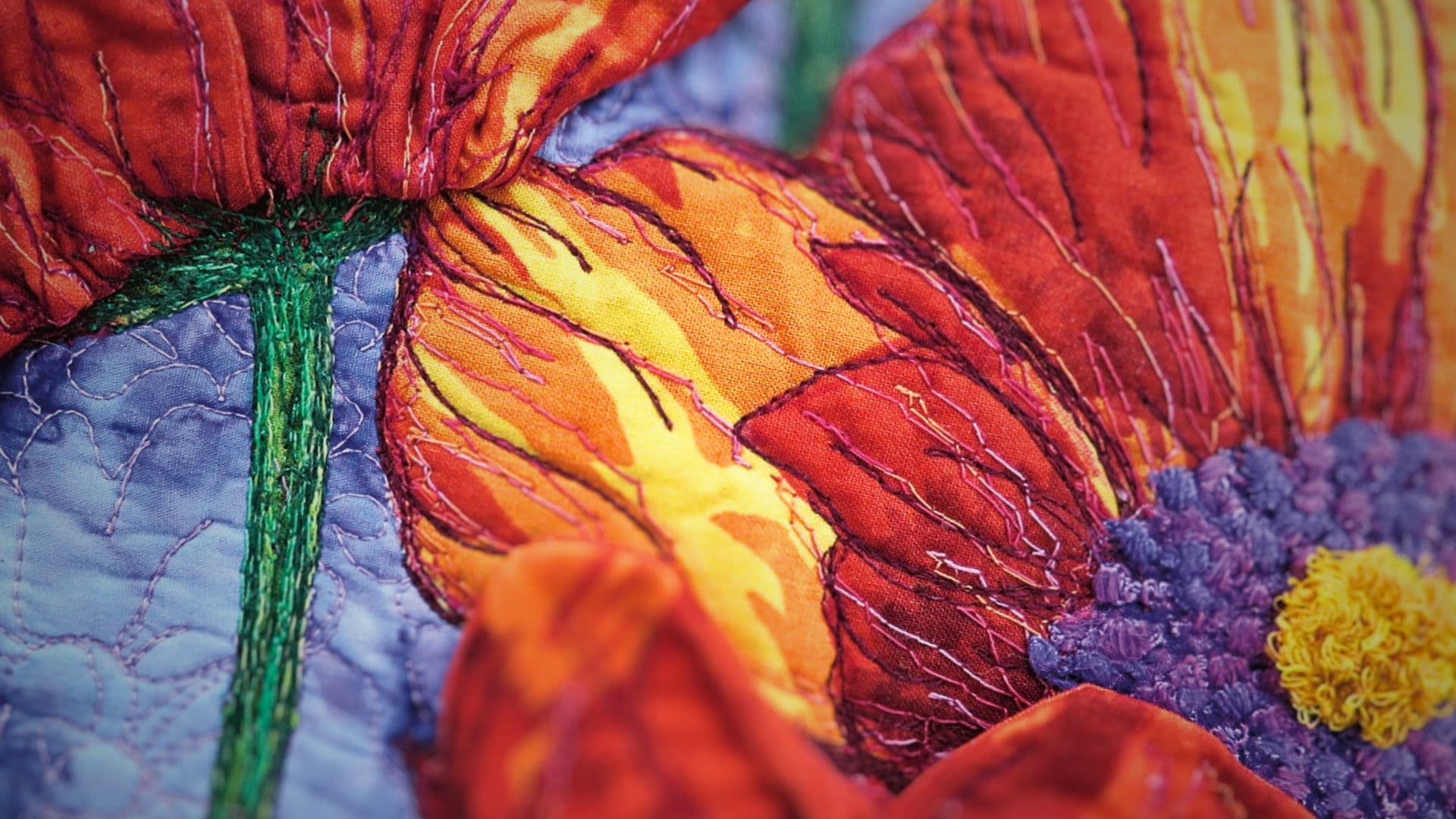
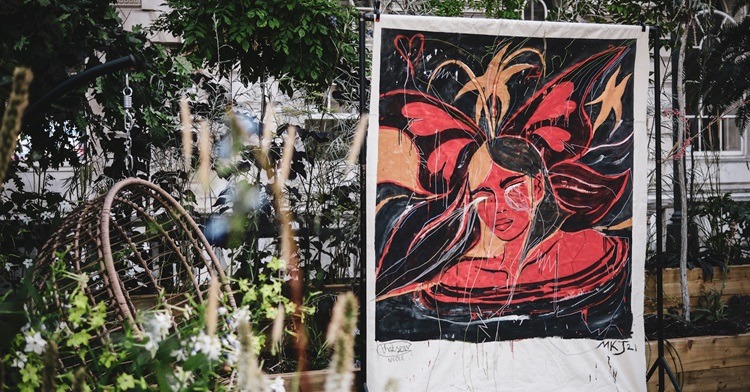
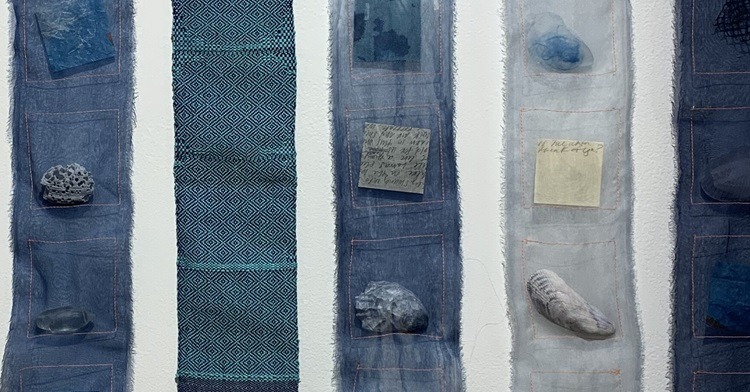
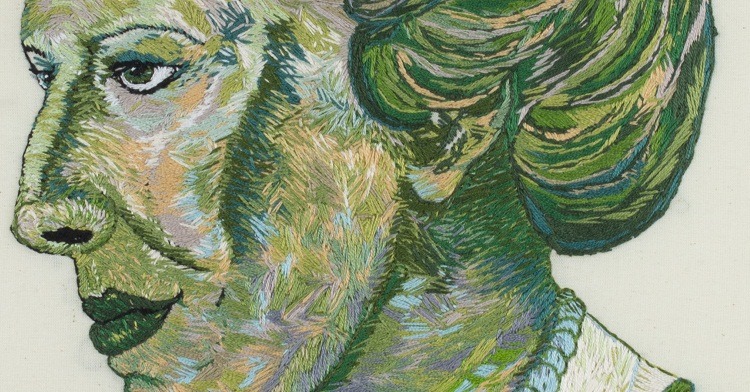
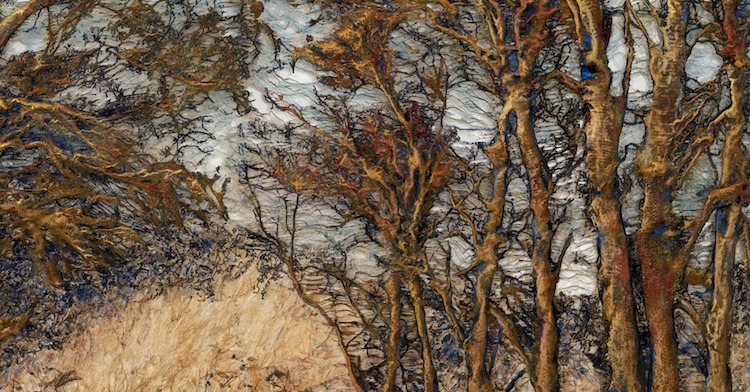
36 comments
Rose Arthur
Wonderful! So inspiring. Thank you.
Anna
Hi Michael,
I have just bought a watercolour off you on Ebay . I have just read this page and was hoping you could send me a picture of one of your large looms as I would love to have a go at making my own.
Regards,
Anna
Michael Crompton
Hi Anna,
Details of how to make my floor standing loom can be found on my website.
http://www.michael-crompton.co.uk
Enjoy my water colour and hope you build a loom.
Let me know how you get on.
Michael
Robb Schinnour
Thank you Michael for your in-depth sharing of your life and working as a textile artist. I currently find myself at a crossroad in my creative work and so take inspiration from what you have written. Warmest good wishes,
Robb
Michael Crompton
Hi, Robb,
I just keep working, writing and researching, weaving and eventually, albeit slowly, come to terms with my creative self.
Keep thinking and enjoy your creative process.
Best wishes.
Michael
Russell Collins
Hi Michael,
You might remember that I was also at BOC all those years ago. Without realising it then we were exposed to
a wealth of experience that would not have been available anywhere else.
I continued to make pots and teach in quite a a few art schools. I even did a stint back at Bishop Otter!
We have now sold our big house with the old pottery and built a new wood framed ‘eco’ smaller one. Which includes
a studio. I now just make for shows and exhibitions with a a.few private orders. Our old group meets every two years
together with Jeff Lowe….. Wasn’t he an inspiration! We are now called the ‘Sawdust Society’.
Glad you work is going well. With best wishes to Mary also.
Best wishes
Russell Collins.
Guibert
Bonjour
Je suis au début de la découverte de la tapisserie et je suis en admiration devant vos œuvres qui permettent de les interprétés de divers façons et qui laissent libre cours à son imaginations.bravo et merci
Michael Crompton
Russell.
Hi, I have been trying to contact you. I got an email address from Jeff Lowe but it seems it was an old one.
Thanks for your email.
Mary and I are well, but fed up with the restrictions.
I am weaving and painting. Have a look at my new website.
http://www.michael-crompton.co.uk
Trust you are both well.
Take care and stay safe.
Best wishes.
Michael
Michael Crompton
Hi Russell.
Great to hear from you. I am just sorry I have taken so long to reply. I rarely look at many of my references.
I well remember you and glad you are still working. I too no longer have exhibitions or take commissions. i just weave for myself.
How the years fly by. I keep in touch with Jeff Lowe and visited him three years ago when I donated some of my work to the Art Collection at BOC.
It is sad that the new VC has closed the Otter Gallery to make way for a Careers Dept!!!!!!!!!
Mary and I are both well…apart from aches and pains.
Have a look at my new website.
http://www.michael-crompton.co.uk
Best wishes,
PS Have a few of your pots around the house.
Andrea Maria Oland
Dear Michael !
Yours were the ones I fell for, such a Beauty. Thank you for showing us how you work. This is how I wish to weave – one day. Not like you, but to learn from you. I had to pause for 20 years because of inflamation in arms, but now I weave, out of a deep hunger for Images.
I have to get made frame looms here where I live, in Tenerife, so yes, it is very interesting to see photos how you have made looms. I will be very grateful if you could send me photo of your frame-looms.
Is it possible to see more of your works as well, Michael ?
They will be printed out and pinned to my board in my working room as Inspiration !
This is my Passion and it is seldom I see tapestry which is like the ones that I would like to make – in me – one day.
Thank you and I wish you Inspiration and All Good for You and your Family.
Me So Happy to know that you exist and create what you do ! Thanks !!
Love
Andrea Maria Oland
a norwegian in Spain
Michael Crompton
Hi, Andrea,
How nice to read such comments.
I will send you an article on how to make my looms and some photographs to further explain their construction. I could also send you by post a selection of coloured postcards. I will need an address.
I have on eBay my latest booklet entitled “Everthing worthwhile starts in the Mind”. It explains more of my working philosophy.
Sorry it has taken time to reply.
Best wishes. Michael
Judith Elder-McCartney
Hi Michael: I live in Ontario, Canada, and just saw your work and read your interview on Textile Artists.org. I love your work. It is truly amazing! The colours, the designs are all so beautiful. Keep up the good work Michael.
Michael Crompton
Hi, Judith,
Thank you for your kind comments.
I have just published my booklet.
“Everthing worthwhile starts in the Mind” . This explores more of my philosophy and working processes. It is available on eBay. But I would send a copy if I had your address.
Best wishes.
Michael
Michael Crompton
Hi Sally,
Have just noticed that i have not replied to you comment. My sincere apologies.
How time flies. We moved over to the Morecambe Bay area in 2004 where i have a studio and continue my tapestry weaving. Glad that our textiles are still in use and still being admired. We are both well and continuing to enjoy life. If you contact me on my email i can send you some images of my latest work.
marymichael@talktalk.net
Best wishes and kind regards.
Michael
Sally Richmond
24 years ago we were out for a drive and passed your cottage in Weardale. We stopped and Mary made us welcome. To this day we have three of your blankets on our chairs, two wall hangings in our living room, they are irises I believe, several beautiful bookmarks and a lap rug which is on my footrest as I write. You were such an inspiration that once I retired I was determined to learn to spin in order to weave my own yarn. I love spinning but the weaving is work in progress. I have never forgotten our visit to you and your wife, oh and Herdwick wool does soften with use I have found.
Joyce Marlow
I was immediately engrossed with the themes within your article, and am contemplating how I can incorporate them in my own work. I’ve been weaving tapestry for 10 years, studying with a master rather than taking educational courses. I am very interested in your use of cotton. Ive always worked with wool, but have struggled to create the crisp shapes I want.
It sounds like you use your pegboard system to change warp sizes in one weaving? How does that work? Do you have any suggestions for a contemporary cotton yarn?
I have so many questions! Your work, and words, are clearly and emotionally expressed and taken to heart. Thank you
I would also like to see images of your loom.
Michael Crompton
Hi Joyce,
Have just noticed on that i have not replied to you contact. My sincere apologies.
Interesting i would like to send you some images but cannot do so on this format.
Do email me @ marymichael@talktalk.net.
I also have an illustrated article on my looms and their construction which i can include.
Hope to hear from.
Michael
Michael Crompton
Hi June,
Glad you found my article interesting and I hope it will inspire you to continue weaving. You might like to know that i have written an article on how to make my upright tapestry frame loom. The construction is quite simple. Just send me your email address if you would like to see more details of my looms.
I use a fork as I can easily bend the tongs to suit the distance between the warp threads. Hold it lightly at the very end to ease the weft threads down.
Best wishes.
Michael
Michael Crompton
Hi,
I forgot to include my email address.
marymichael@talktalk.net
Michael
June Lister
Michael…..So happy to find your article and see your inspirational weaving. I started tapestry last year and it is very quickly taking over from my floor loom weaving. Will be taking a workshop from Rebecca later this year on colour gradation and look forward to learning from her.
I am a Yorkshire girl now planted in California and weave my days away……Thank you for your inspiration , your colours are stunning and I was happy to hear you also use a silver fork……
Happy weaving…….
Michael Crompton
Caroline.
Thank you for your kind comments.
I too like to read and try to understand how and why other artists reach their ideas and concepts. When I visit exhibitions I always want to know more of the artist’s thinking. This is so often missing and I feel that the artist is missing a trick in not elaborating and encouraging the viewer to understand more.
Best wishes,
Michael
Caroline
Thank you Michael. You create beautiful work. I do not weave, however, I always enjoy reading about other artistic people.
Michael Crompton
Hi, Ros.
Glad that you have responded to my work and processes. Like you I feel I know my equipment better for having made it from a range of materials and sources. Try a four pronged fork as a beater as you can adjust the tines to suit the number if threads to the inch.
Try adding more weft into the warp to avoid the fabric “wasting in.” This is not easy to do but very worthwhile to keep straight edges.
Keep thinking and enjoy your weaving.
Best wishes,
Michael
Ros Hornbuckle
I like the abstract nature of your images. I too have returned to a more simple tapestry frame, using a shop garment rail on wheels, though I do use heddles. I like to see my weaving all the time, and I use a dog comb as beater. My latest invention is to use IKEA curtain hanging steel clips on the sides of the weaving to hold it out to the correct width as I use a lot of eccentric weft. I’ve also started using caravan awning poles( donated) for the sides to make them adjustable. I applaud any one who makes their equipment from things they find around them.
Marjorie
I can’t say how much I loved your work. Were these lovely colours your escape from the soot and grime of Radcliffe? I was born there, (Park Street, complete with cotton mill and paper mill) before your time, so know exactly what it was like. I keep wondering which school you went to with the enlightened teachers? But of course things were different by then.
I think my favourite is the “Oak in Moonlight”. It would be hard to choose the best of all the others.
Art is only my life-long inspiration; textile art spare time but I have inspired my daughters into card design (see frillybee) and jewellery design (Hollowbourne Hoard).
Michael Crompton
Greetings Marjorie,
It is good to hear from you, and living in Radcliffe. We lived in Ainsworth Road until I was eleven and then moved up the road to Three Arrows. My primary school was St Andrews and it was whilst at Stand Grammar that I was made aware of the Arts and Craft movement. I did have a holiday job at Taylor Monks and we’ll remember the Lancashire Paper Mill.
My colour schemes come from nature and not the industrial palette. Having travelled widely my colours have become more and more dominant, primary and very strong. I photograph, paint and sketch whilst travelling and sometimes I wrap colour on card to see how one colour reacts with its neighbour. I am glad you respond to my work and hope that you continue to explore the world of art and to encourage your daughters. Give my best wishes to Radcliffe, I have not visited the town for many years.
Best wishes.
Michael
Frank & Sylvia Hough
Michael, We first met you and Mary in Namibia, and saw at first hand where you get your inspiration from. Then you inspired us to go to Nepal and again looking at your Nepal Series can identify the places and the inspiration again. So much so that one of your Nepal Series now has a pride of place in our home, and admired by many.
Frank & Sylvia
Michael Crompton
Rita,
Nice to hear from you and thank you for your kind comments. It was good to hear that my loom is being used to good effect. My studio is much smaller and now I weave smaller tapestries and do not require a roller system for large pieces.
I hope you still weave and do pass my best wishes to Cath.
Michael
Michael Crompton
Greetings Ramona,
I will need your email address to send you an image of my loom. My email address is : marymichael@talktalk.net.
I do not use linen for warps. I use a three ply light coloured rug yarn, 80%wool and 20%nylon. This a put through a spinning wheel to add more twist and hence strength. My looms has pegs top and bottom, four to a linear inch, and a warp continuously and use a cross bar or stick to increase tension across the width of the warp if needed.
I have collected my yarns over decades but I am unsure where I can obtain this quality nowadays. My yarn store is full and sufficient to supply my needs.
Hope this helps.
Best wishes. Michael
Ramona
hello! Michael, I so enjoyed reading about your family history in textile industryand deep ties and experience in weaving and tapestry. I learned tapestry weaving in 1974 in college on a simple frame too, with a continuous wrap using finger shedding. May I ask the source for your wools, and do you use linen as the warp , if so, what size? I would really like to see an image of your loom. I am ready to retire and wish to go back to tapestry, interpreting designs and images I enjoy. Thank you for your story, your designs are intriguing, And I enjoy your use of color.
Ramona
Rita Corbett
Michael. I came to see you before you moved West and bought your weaving loom which was too big for your new abode. I hadn’t read your specifications correctly and was a bit taken
aback when I saw the size of the loom. However I took it home to Dumfries and when I couldn’t get the courage to warp it up decided to find it a home where it would be used and loved.
It now resides with my friend Cath, in Drummore near Stranraer. It is warped up and her second piece inspired by lichen is being woven on it. She loves it and finds it makes weaving easy which allows her to concentrate on the design as she weaves.
Best wishes. I love your work and your thoughts which inspire your work.
Rita Corbett
Carol Naylor
Wonderful to see your work here Michael. You may remember me from “Bishop Otter” in that I taught in the Art department with Jeff Lowe and others, and I think when you had your exhibiiton there I would have been head of the art department too! The Stanhope tapestry in particular is most impressive.
Michael Crompton
Greetings Deborah,
Glad you do “simple”. I could easily send you via email images of my frame looms. All I require is your email address.
My email address: marymichael@talktalk.net
Regards,
Michael Crompton.
Jeff
I would love to see your looms, as well! owlsperch200@gmail.com. Fascinating article, breathtaking work!!
Michael Crompton
Greetings Carol,
It was good to hear from you. I well remember meeting you at Bishop Otter during my 2000 exhibition in the “Otter Gallery”. You may be interested that in March we travelled down to Chichester where I donated four of my tapestries and ten water colour paintings to their Art Collection. I am unsure whether the College has their extensive collection of art on an accessible website or simply a section on the main college site. Thank you for your kind comments.
Regards. Michael
Deborah Pawle
I found this article fascinating, such beautiful ideas and thoughts. I am a tapestry weaver, not professional and I also use finger shedding and an old fork so was interested that Michael did as well, it would have been good to have seen a picture of his loom, I like simple.